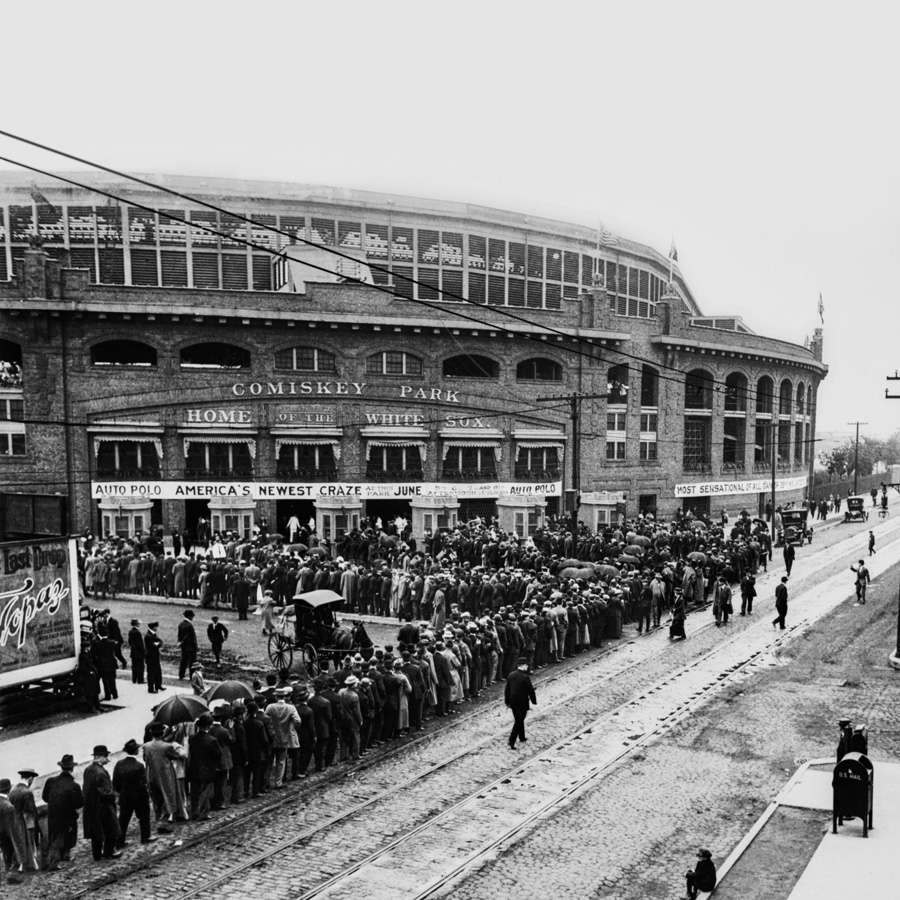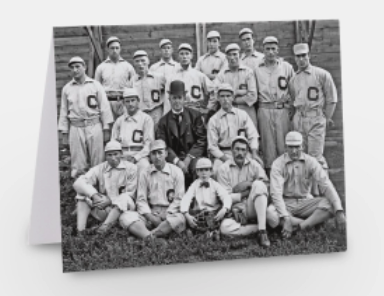 |
Card #1: CHARLES COMISKEY AND THE AMERICAN LEAGUE CHAMPIONS (1901)
CAPTION: In 1900, a 41-year-old Charles Comiskey moves his Western League franchise from St. Paul, Minnesota, to Chicago’s South Side. His White Stockings are a minor league team with major ambitions. When the “Western” becomes “American” in 1901, dozens of National League stars defect to the upstart league. One of them, pitcher (and manager) Clark Griffith, goes 24-7 as he leads Comiskey’s team to an 83-53 record and the inaugural AL pennant – their first of six. Front (l. to r.): Herm McFarland, Frank Shugart, Boy Mascot, William “Dummy” Hoy, Billy Sullivan; Middle: Jimmy Callahan, Charles Comiskey, Clark Griffith; Standing: Fred Hartman, Sam Mertes, Joe Sugden, Frank Isbell, Fielder Jones, Johann Jack Katoll, Jimmy Burke, Wiley Piatt, Roy Patterson, Clarence “Pop” Foster.
|
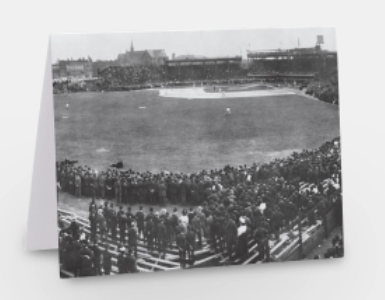 |
Card #2: SOUTH SIDE PARK (1906)
CAPTION: At the deciding Game 6 of the World Series, some 19,249 South Side Park fans cheer their White Sox to an improbable 8-3 win over the heavily-favored Chicago Cubs. This is known as the first “Subway Series,” though Chicago will have no subway until 1943. It’s the first of three White Sox championships (1906, 1917, 2005). In use since 1900, this third version of South Side Park is abandoned in 1910 in favor of a much larger, steel-constructed Comiskey Park, just three blocks north. They rename the old wood stadium Schorling Park, after Charles Comiskey's son-in-law. It’s home to the Negro Leagues’ Chicago American Giants from 1920 until it burns down in 1940.
|
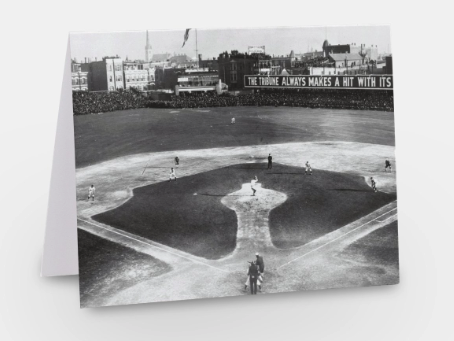 |
Card #3: THOSE WONDROUS HITLESS WONDERS (1906)
CAPTION: It’s October 11 at West Side Park for Game 3 of the 1906 World Series, the first crosstown classic. A local scribe dubs the White Sox “Hitless Wonders,” as the team’s .230 batting average ranks last in the AL. With 116 wins (still the MLB record), the mighty Cubs are heavily-favored. This is only the third World Series – bickering owners canceled the 1904 event – and the teams will play six straight days, alternating parks. This Game 3 shot shows Cubs pitcher Jack Pfiester as he tries to escape a bases-full, no-outs jam. He gets a popup and a K (on a failed bunt), but then George Rohe clears the bags with a triple. The Sox win 3-0, on their way to a 4-2 series upset.
|
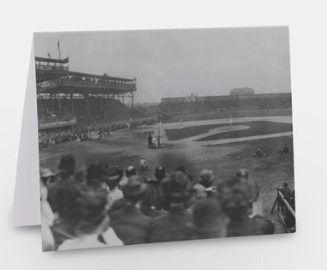 |
Card #4: CHICAGO CITY SERIES (1909)
CAPTION: It’s October 9 at South Side Park, and the White Sox are playing the Cubs in Game 4 of the Chicago City Series. This (mostly) best-of-seven postseason matchup is for local bragging rights. It starts in 1903, after the AL champion Boston Americans challenge the NL winners, the Pittsburgh Pirates, to the first World Series. Other teams want to make some extra money too, so multiple City Series are born: Browns vs. Cardinals in St. Louis; Athletics vs. Phillies in Philadelphia. Cincinnati and Cleveland take it to the next level with their Battle of Ohio. But it’s the Chicago series that’s played most often and in front of the most fans – often rivaling World Series crowds. The Cubs win this game 2-1 and the 1909 City Series. But, surprisingly, it’s the Sox who get to brag the most, going 19-6-1 overall against their rivals until the series ends in 1942.
|
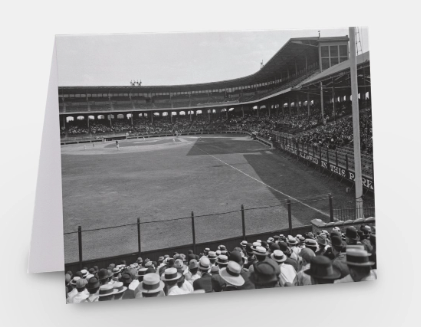 |
Card #5: WHITE SOX PARK (1910):
CAPTION: Bleacher heads in hats enjoy a game at Charles Comiskey’s brand new White Sox Park. The name will change to Comiskey Park in 1913 – it’s what people have always called it. Some attribute frequent low scores here to Sox Hall of Fame hurler Ed Walsh, who reportedly helped architect Zachary Taylor Davis with the dimensions: a very pitcher-friendly 362 feet down the lines and a whopping 420 to center. Known as a penny pincher, Comiskey chooses to block some sight lines with annoying posts. Those newfangled cantilever designs cost too much! The “No Betting Allowed In This Park” sign portends a 1919 scandal that will prove far more costly.
|
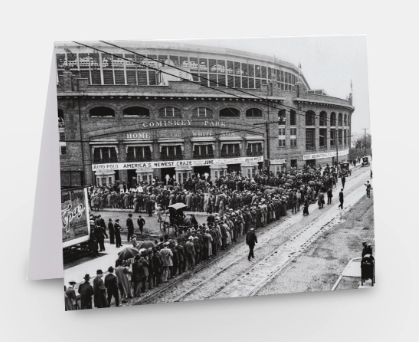 |
Card #6: COMISKEY PARK (1913)
CAPTION: Built in 1910 by the same architect who would later build Weeghman Park (aka Wrigley Field), the 28,000-seat “Baseball Palace of the World” is home to the South Siders through 1990. At various times, the Chicago Cardinals (NFL), Chicago American Giants (Negro Leagues) and Chicago Sting (NASL) also play here. It’s fairly common knowledge that Comiskey hosts the first MLB All-Star Game in 1933. But did you know boxer Joe Louis wins the first of his 11 consecutive heavyweight championships here in 1937? In front of 65,000 fans? Or that auto polo – all the rage from 1911 to the late 1920s – even exists? Here, a line forms to see the automotive action.
|
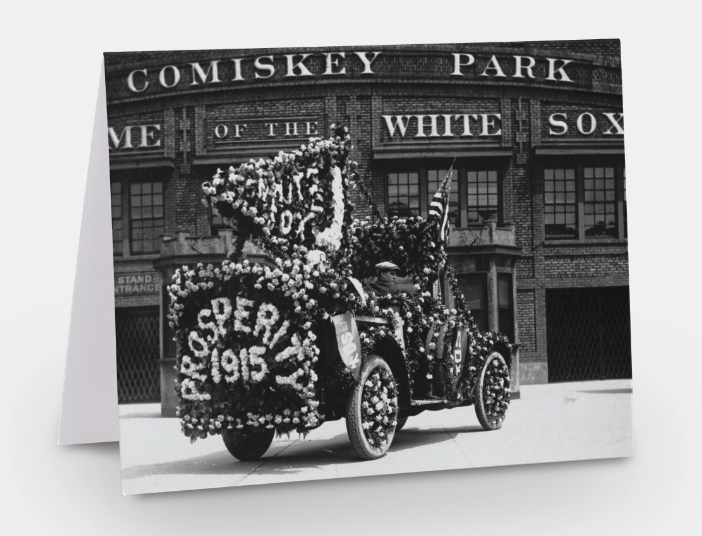 |
Card #7: PROSPERITY FLOAT (1915)
CAPTION: On Chicago’s South Side, 539,461 fans will flock to Comiskey Park to see their beloved White Sox play baseball this year. They also will pay to watch football, boxing and something called “auto polo.” Team owner Charles Comiskey likes to say his 5-year-old stadium “belongs to the people.” There are comfortable ramps instead of stairs, color-coded tickets for designated gates and box seats ($1 or more) to separate the swells from the bleacher (25 cents) riffraff. He also invites the masses to come (for free) to their church picnics and union rallies – even army basic training. Generate pride. Impress your friends. Sponsor a float to American prosperity. Everybody wins.
|
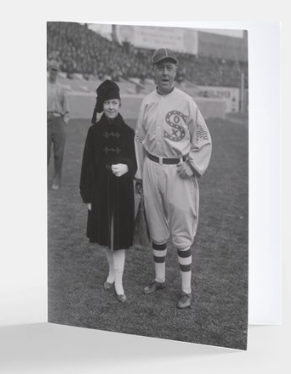 |
Card #8: CLARENCE "PANTS" ROWLAND (1917)
CAPTION: Clarence earns his nickname as a boy, when he struggles to run the bases in his dad’s much-to-big trousers. He’s an unlikely hero of the 1917 White Sox championship, having left his Iowa bartender job to take the helm of the South Siders in 1915. Rowland has done everything in baseball but play in the major leagues, earning the respect of Charles Comiskey (but few others) for his persistence. After the World Series win over John McGraw’s NY Giants, Pants reportedly says, “Mr. McGraw, I’m glad we won, but I’m sorry you had to be the one to lose.” The reply? “Get away from me, you @#$%& busher!” Rowland gets fired in 1918, which spares him the misery of the 1919 Black Sox scandal. At 1917 World Series, with daughter, Beulah.
|
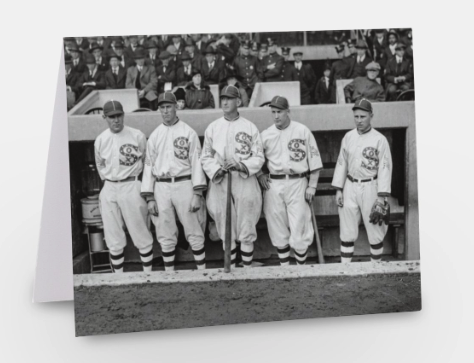 |
Card #9: SHOELESS JOE & FRIENDS AT THE WORLD SERIES (1917):
CAPTION: The South Siders go 100-54 – still the only Sox team to win 100 – and lead the American League in runs scored and team ERA. They face John McGraw’s mighty NY Giants in the championship and, because of rain and travel days, are able to rely on aces Eddie Cicotte (28-12, 1.53 ERA) and Red Faber (16-13, 1.92). The duo pitch 50 of 52 innings as the Sox cruise, four games to two. All five White Sox outfielders at the 1917 World Series (l. to r.): John Edward “Honest Eddie” Murphy (.314 BA), John Francis “Shano” Collins, Joseph Jefferson “Shoeless Joe” Jackson (.301), Oscar Emil “Happy” Felsch (.308, 102 RBI) and Harry Loran “Nemo” Leibold (5 feet 6 inches tall, nickname from the Little Nemo comic strip)
|
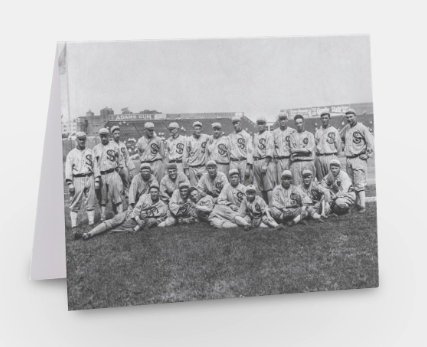 |
Card #10: NOT THE BLACK SOX (1917)
CAPTION: Overshadowed in history by the 1919 gambling scandal is the White Sox club that actually wins the World Series, four games to two over the NY Giants. It’s the only Sox team to win 100 games. Front row (l. to r.): Joe Benz (P), Swede Risberg (SS), Buck Weaver (3B), Shoeless Joe Jackson (LF), Happy Felsch (CF), Jim Scott (P), Clarence “Pants” Rowland (Manager), Clarence Rowland Jr. (Ball boy), Ted Jourdan (1B), Mel Wolfgang (P) and Nemo Leibold (RF). Back row: William Jethro “Kid” Gleason (Coach), Ray Schalk (Hall of Fame, C, played from 1912-29), Eddie Collins (HOF, 2B, 1906-30), Chick Gandil (1B), Eddie Murphy (OF), Fred McMullen (IF), Eddie Cicotte (P), Shano Collins (OF), Joe Jenkins (C), Dave Danforth (P), Lefty Williams (P), Byrd Lynn (C), Reb Russell (P). Not present: Red Faber (HOF, P, 1914-33)
|
